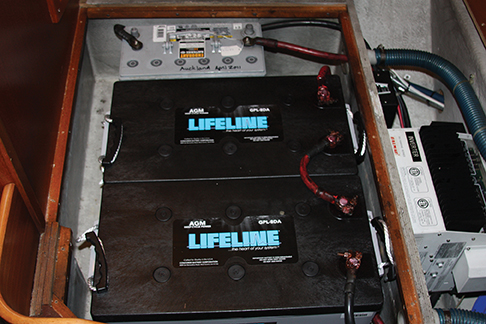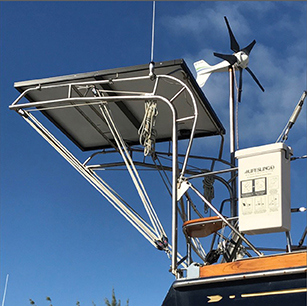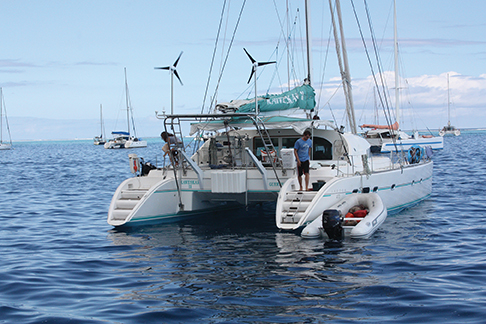How to build an energy system that is robust, reliable and up to the rigors of offshore sailing (published April 2017)
For the past 30 years we have been able to meet the challenge of designing reliable offshore power systems that are fully sustainable with the use of wind turbines and solar (photovoltaic) panels without reliance on a diesel engine turning a generator or alternator. Today, a typical cruiser’s energy requirements are easily double the average a decade ago, but during that time frame, efficiencies of solar cells have more than doubled with the cost per watt being well below half of prices then.
When we start working with clients to assess their energy needs, we encourage consideration of their passage making lifestyle first, as days offshore are the periods of highest demand. In many cases, due to angle of heel or excessive sea conditions, it is not possible or practical to run an engine or genset to charge the batteries. Heeling or rough seas also can cause air locks or fuel contamination shaken from the tank bottom. The solution is to have a robust alternate source of energy to keep your batteries topped up.
ENERGY AUDIT
Boat builders in general do not size your electrical system for cruising, as the majority of their customers have proven to be weekend sailors, thus the small house battery bank and low-output alternator. Once you transition into a cruising lifestyle, you will have daily loads that will average out to a certain quantity of predictable amp-hours per day consumed. It is best to develop a spreadsheet of all desired DC loads on board, determine their average amperage and multiply by the number of hours per day each device will operate; be conservative.
This assessment must include inverter loads. You will need to divide the wattage of each AC device by 12.5 volts and then add 10 percent for efficiency loss. This will give you amps that you will again multiply by the hours per day each device is forecast to operate. For efficiency it’s always best to choose appliances with DC compatibility over using an inverter. This energy calculation exercise should give you a good amp/hours per day consumption number to act as the baseline for calculating the rest of your system requirements.
 BATTERY BANKS
BATTERY BANKS
Battery technology is quickly evolving but would require another article to cover all of the details. It suffices to say that the proven technology, the deep cycle lead acid (flooded, AGM and Gel) battery, is preferred by the majority of cruising sailors. Lithium technology is quickly evolving and may soon be immune from the risk of “thermal runaway”, its weight to power density being highly desirable.
In all cases there is a limit to the rate and depth of discharge each battery type can tolerate without premature failure. In most cases, assuming a good battery pedigree, you will see years of reliable service by sizing your batteries to be twice the amp hour capacity as your calculated daily load. Not discharging below 50 percent will avoid stressing the internal lead plates, which is especially important under excessive motion and high temperatures. Your starter battery should be sized to be your critical back-up house battery, not just for cranking over the engine.
BATTERY HEALTH
Leaving a battery discharged for several days is second only to excessive discharging for killing batteries long before their life expectancy. Discharged conditions allow for sulfur crystals, not charged back into the sulfuric acid solution, to stick to the lead plates, slowly reducing the functional capacity of the battery. Regular, full recovery, charging prevents sulfation from happening.
Flooded batteries and some AGM batteries benefit from a periodic equalization cycle (conditioning), but will require monitoring and good ventilation. Most current smart chargers and regulators provide an equalization mode. This process helps to remove moderate sulfur scaling. Other AGM and Gel batteries, not tolerant of equalization, will ultimately succumb to sulfation.
When reconfiguring your battery bank to accommodate your calculated daily load, it will most likely end up being significantly larger. It is bad science to add new batteries to old. The old batteries will degrade the new ones to their lower average potential. Secondly, correct charge regulation is critical.
All charging devices must be appropriately regulated for the battery type (AGM, Gel, Flooded) from the alternator, AC charger, wind turbine and solar array. These days, the most efficient charge algorithms rely on a temperature input. If you opt to not install the optional temperature sensor, the regulation device will still regulate, but most will default to a “hot” battery rate to avoid cooking the battery during the bulk charge phase if high temperature conditions existed. This results in unnecessarily long charge periods when the battery is actually at an acceptable temperature for bulk rate charging.
Your secondary batteries (starter, windlass, etc…) should be cascade-charged by the smart charger off of your house bank. The regulation device determines when the voltage is high enough at the house bank to safely divert charge at the correct charge profile for each smaller battery. This system allows all batteries to have healthy and optimal charge rates rather than going through the traditional battery isolator that creates arbitrary charge rates and loses 0.6 volts through each diode feeding the batteries and in many cases cooking the smaller batteries.
 CHARGING WITH WIND AND SOLAR
CHARGING WITH WIND AND SOLAR
If your batteries have been sized correctly, a 50 percent discharge should equate to at least your normal 24-hour cruising lifestyle consumption. If clear sunny days and wind speed were constant the rest would be easy. Cruising realities, by nature, are dynamic and not always predictable (otherwise everyone would be cruising). This requires some intuitive fudging with sizing your charge sources.
A wind turbine’s minimal foot print is often desirable. When you consider installing a turbine, think of those inevitable long overcast days without high solar energy and the ability to tap into onshore breezes after sunset. Turbines are electrical-mechanical devices fully exposed to the corrosive ocean environment and a misplaced boat hook; warranties rarely exceed three years. The most common complaint is noise but in many cases that noise is simply the result of improperly balanced blades. Each has it’s own peak wind speed decibels, influencing when you will be shutting it down, electrically or mechanically (safety precautions are essential in high winds). Unlike solar, you cannot just open the circuit, you must apply breaking magnetically (short circuit) or divert the power to a load dump (often a heating element in a water heater).
Solar photovoltaic cells, having no moving parts, are extremely reliable with up to 15 years of warranty (25 for land use) for the more rugged aluminum framed tempered glass panels and in most cases lasting over a decade beyond their warranty. They do require valuable surface area providing, at best, 18 watts per square foot. The less efficient the panel, 15 percent efficiency, the more square footage required, with the highest efficiencies now exceeding 22 percent.
Panels are rated through a laboratory test with a 1000 watts per square meter flash test at “solar noon” at 25 degrees C. This equates to the optimal performance moment, but not it’s tolerance for shadows or low angle sunlight.
Cruisers should be buying panels based on watt-hours per day, per square foot, not watts at solar noon. Low cost, low efficiency panels can be tempting with half the dollar/watt capability as a high-efficiency panel. This penny-wise, pound-foolish purchase would oblige you to use upwards of 50 percent more surface area and mounting hardware for the same daily production.
The highest efficiency mono-crystalline cells can now be found in bendable and walkable panels as well. These are adaptable to Biminis and critical deck areas, but without the durability of glass frame panels. Depending on the materials used, there are varying degrees of resistance to UV and flexing deterioration. Warranties on flexible panels typically do not exceed five years.
One of the biggest improvements in solar charging over the last few years has been the open source access for most charge control manufacturers to incorporate Maximum Power Point Tracking. The MPPT algorithm actually manipulates the voltage, through momentary reduction of amperage, to always be higher than the battery voltage. This allows for charging at lower sun angles, cloudy periods and partial shadows. This results in over 25 percent more charging amp-hours being delivered with any panel.
Having multiple charge inputs can have big advantages when configured with automatic on/off relays. These are made by several companies and allow you to take advantage of your wind and solar when the batteries are full, with nothing to do. My favorite secondary use is making water with DC desalination whenever surplus power is available. This results in my typically finding my 200 gallon tank overflowing into the ocean (water makers like to run).
Another favorite is having a separate engine room blower exhale the interior living space late in the afternoon and replace with drier cooler air before the interior accumulation of humidity and heat goes to dew point. This has solved my mildew issues with the comfort of drier sheets and surfaces in the evening hours. Another efficient load dump is dropping your freezer and refrigerator temperature to the lowest optimal range, thus avoiding many night-time cycles. There are many other examples but it helps to remember that it takes measurably more energy to replace battery discharge than using surplus energy with a full battery when available.
Outfitting a boat for safe cruising should be cost effective, not cheap. Energy systems bought on price rather than reliability will ultimately fail to meet your needs. I’ve heard many times that a portable 2000-watt generator is all you need. Really? They aren’t U.S.C.G. compliant and may void an insurance claim for good reason. This has been tragically demonstrated by those who have suffered through electric shock (touching the ungrounded case on a wet deck), carbon monoxide poisoning (exhaust drifts down the companionway), severe burns (generator tips during beam wave and ignites). In my book, this is not cost effective, just a cheap way to avoid setting up an energy system in a seaworthy manner.
Offshore power management is a broad topic. There are many specific needs for the individual cruiser that can be met by first analyzing and prioritizing critical needs, and then planning and installing a system of charging and power management technologies that work together with your specific goals in mind.
Unfortunately, there is no one-size-fits-all solution because each cruiser has different needs and compromises are inevitable due to limited space. Understanding the technologies and designing the system can be one of the joys of cruising, with the added benefit of feeling confident about how your system works while out at sea!
Bob Williams is a lifelong cruiser and is the founder of SALT, which builds energy systems for cruisers and for many other onshore clients.















